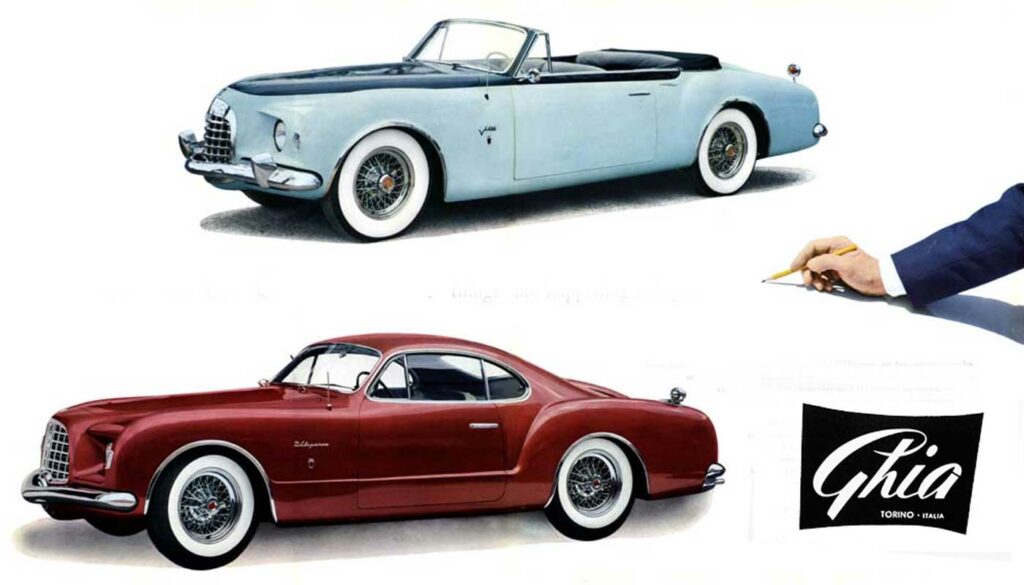
The American contract
There are in the history of companies, just as in the history of nations, certain fateful episodes, which have an influence on the course of events well in excess of their actual importance. Chrysler’s request to Ghia to build for them, to their design, a special body on a Plymouth chassis, is one of these episodes. It might have been considered a contract like many others, a routine job. Instead of which it became the key to Ghia’s entry into the big world of international design.
In 1950 Chrysler was looking for a low cost supplier for the construction of their prototypes, Italy thanks to the Marshall plan was very attractive as it offered low cost labor and high quality. Consequently, Chrysler launched a competition between Pinin Farina and Ghia for the construction of a prototype based on a Plymouth chassis. The rules were simple: build the car as if it was a production model following the blueprint and design provided by the American car manufacturer. Chrysler sent 2 chassis to Turin and the winner would be its official partner and consulant. Mario Boano, dissatisfied with the model which the Americans proposed, decided to do it his own way, and asked Chrysler if he could produce it to his own design. The result was a body on a Plymouth chassis, very similar to the Alfa Romeo 6C 2500 which had won him the Gold Cup at the Stresa Concours in September 1949. The Americans liked it, although for other reasons than Boano’s – not for the style but for the quality of execution.
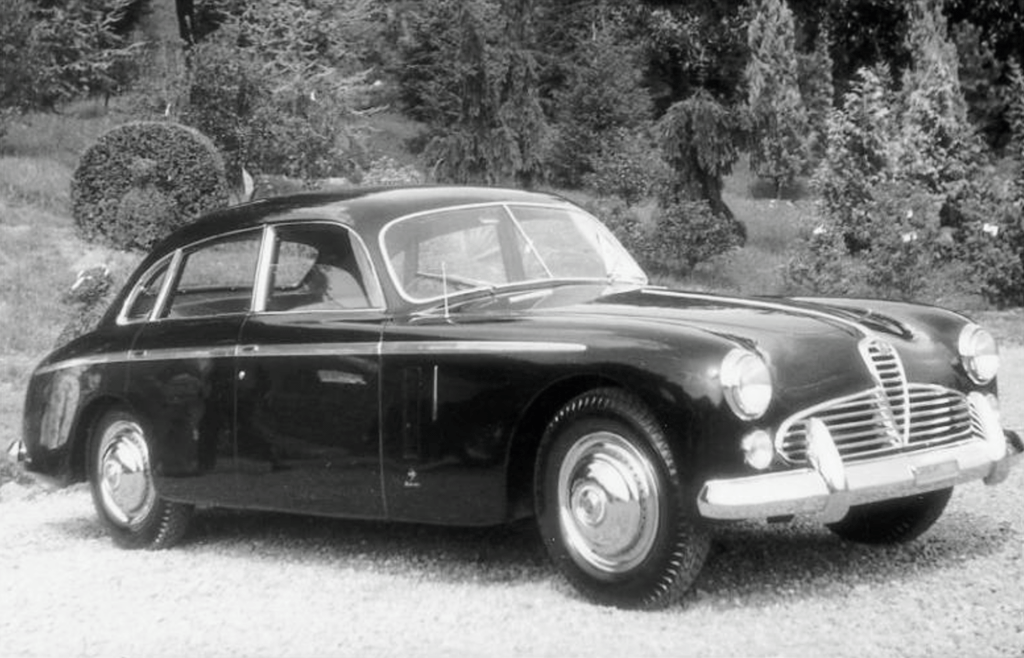
This was the casual way, the felicitous chance, which allowed Virgil Exner, Chrysler’s head stylist, to build his first idea cars in Italy. The first commissions were two experimental models, the Chrysler K-310 and its cabriolet version, the C-200. Virgil M. Exner and his team sent the designs to Italy along with a scale model, which the Ghia craftsmen reproduced faithfully, brilliantly overcoming the problems which arose during production. This was the definitive trial for the relationship which was to last a decade. The Plymouth prototype was also exhibited, at the 1950 Chicago Motor Show, with the name XX 500, a name which still identifies this model.
Travelling hopefully
Ghia’s great turning point came without warning, and no thanks to either Boano or Segre, unless we count having grasped the opportunity.
Towards the end of the Forties, Fiat was in the middle of reorganisation. With the money from the Marshall Plan Valletta had formed an alliance with Chrysler, obtaining from this American firm, judged the most adaptable to European needs, information, plans and projects. There was an intensive exchange of visits and some plans for integrated production, as Dante Giacosa records in his Memoirs, but nothing came of it. However, the friendly relations between Chrysler and Fiat were not interrupted.
It was quite natural that when he decided to build some research prototypes in Italy, the head of Chrysler styling C.B. Thomas should turn to Fiat for information about firms able to take on the contract. At the time labour in Italy was extremely cheap, and in addition there was a craft tradition, especially in the field of coachwork, which had no equals anywhere, except maybe in France. Luigi Gajal de la Chenaye who was Fiat’s sales manager at the time sent two names to his American friend: Pinin Farina and Ghia.
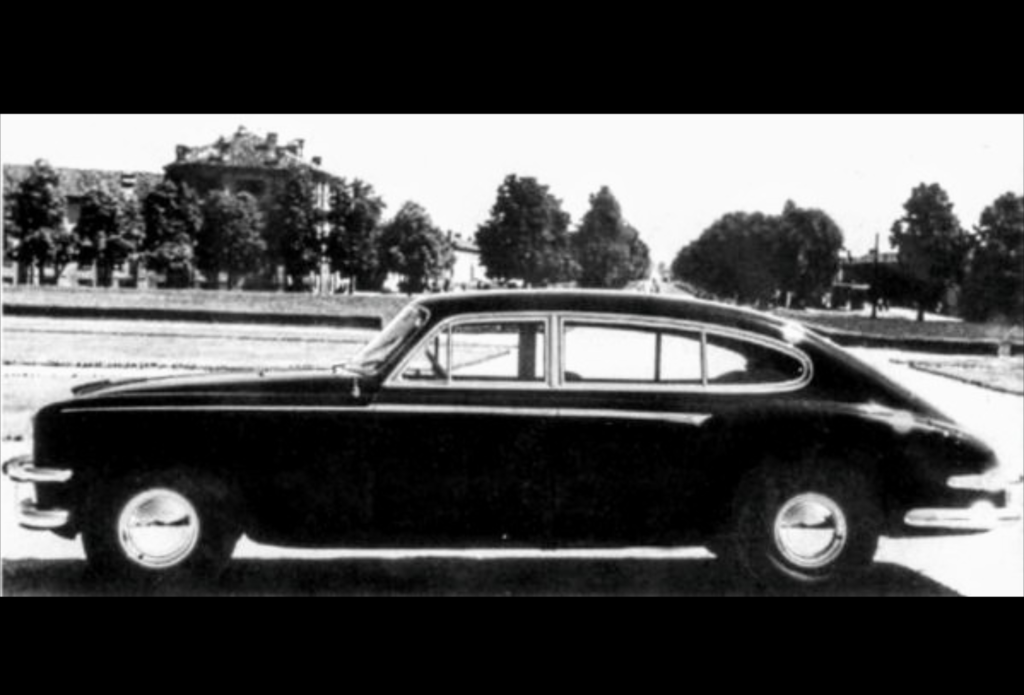
Chrysler contacted both companies and commissioned a trial prototype from each. Two Plymouth chassis were sent to Turin with two identical sets of designs; the commission had to be carried out to the letter, with only marginal variations where they were absolutely necessary.
Mario Boano looked the designs over and immediately decided that they could be improved. At the risk of losing the order he wrote to Chrysler requesting authorisation to carry out substantial modifications to the model. Thomas’s answer was swift and clear, “Do whatever you think best”.
The two prototypes, one by Ghia and one by Pinin Farina were ready almost together and were sent to America together. Pinin Farina had kept faithfully to the design, but Ghia had re-interpreted one of their models on an Alfa Romeo 6C 2500 which had been extraordinarily successful, both with the judges and the public, at the Villa d’Este Concours in September 1949.
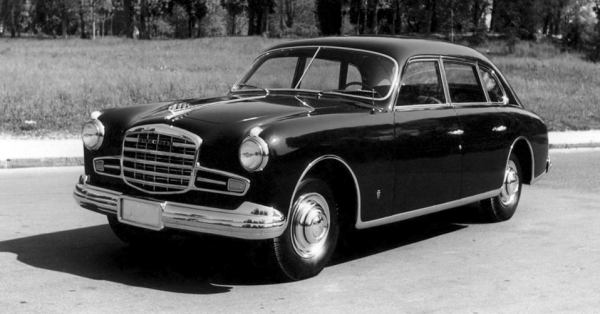
The Chrysler stylist unerringly chose the Ghia model. Truth to tell, but Boano and Segre only found this out much later, it was the quality of the work and the low cost which struck the Americans, rather than the model’s style, which was rather massive. Ghia boasted of the fact that seventeen coats of paint were required to produce the splendid paint job on their cars. At least, this was the motivation behind the awarding of the Artistiea Cerbiatta, a sculpture by Enrico Saroldi, to the Alfa Romeo 6C 2500 at Villa d’Este, in addition to the Gold Cup. It was a special award for the car with the best paint job. The news that they had been chosen by Chrysler arrived at Ghia delightfully accompanied by a gift and an invitation: the gift was a brand new Plymounth for Boano and the invitation was to Detroit to work out the next contracts.
Commendatore Mario Felice Boano spoke no English and so naturally Luigi Segre went with him. Just as naturally, during the negotations, Segre did most of the talking, although when they returned to Italy the contract in their pocket was a “consultancy” contract with Chrysler in Mario Felice Boano’s name.
In the months which followed relations between Chrysler and Ghia became increasingly close and it was Luigi Segre who pulled all the wires in Italy. The first of these special commissions was the Chrysler K-310 built to drawings and models sent from America, and on this occasion Ghia had to stick to them strictly. Straight afterwards the convertible version of the same model was built, the Chrysler C-200.
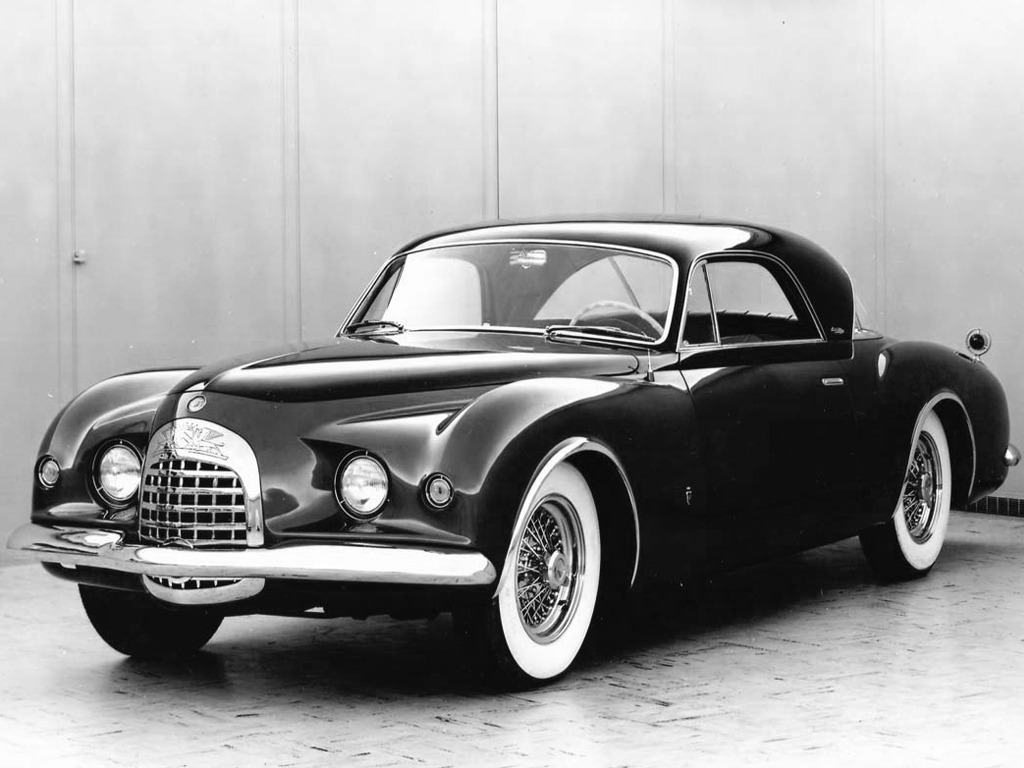
The two models were designed by the Chrysler styling centre which was officially directed at the time by King, but in practice by someone already well-known in the world of American stylists, and who thanks to Ghia was to become famous in Europe too, Virgil Exner.
Segre went to America with the C-200 convertible, by himself this time, and the journey was not without a certain amount of adventure: during unloading at New York docks the precious model was dropped onto the quayside, starting a series of maritime “misadventures” for the Chrysler-Ghia prototypes, disadventures which culminated with the loss of the Norseman when the Andrea Doria sank.
In Detroit Virgil Exner and his team were waiting to welcome Gigi Segre.
Virgil M. Exner, Chief Stylist
Luigi Segre’s first impressions of the American way of doing things were not very encouraging. Notwithstanding his excellent credentials which gave him an entree into the highest management levels, Segre realised immediately that, amongst the big American motor manufacturers, Chrysler was perhaps the least open to European styling ideas.
In those years the marque was synonymous with the petit-bourgeois solidity of the middle classes of the most conservative states; it was a huge market with which the management, curiously consisting for the most part of Texans, was more than satisfied.
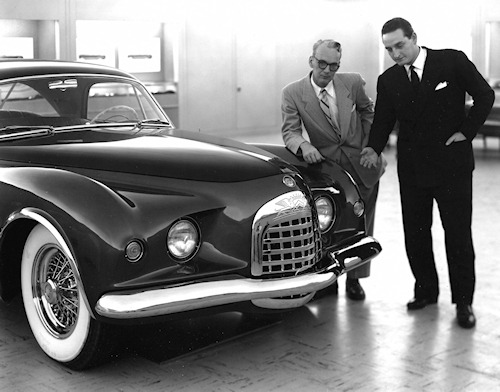
As often happens, this decidedly unpromising premise had an unexpected, very positive, development, thanks to a series of favourable circumstances. These were first and foremost of a personal nature: Luigi Segre spoke English rather well, and this certainly contributed towards facilitating relations with the Chrysler men, but the presence in the American group of an fluent Italian speaker, Paul Farago, definitely constituted an important element. Last of all, and perhaps this was the most important element of all, the immediate liking, which later became friendship, between Luigi Segre and Virgil Exner.
The two men, both of whom loved their work and were motivated by a similar desire for success, realised straightaway that an agreement between the big American manufacturer and the small Italian coachworks would be of enormous advantage to both. For Segre the advantages were obvious; a link with Chrysler meant a breakthrough for Carrozzeria Ghia which would be difficult to achieve otherwise, for Exner, the opportunity to get out of a difficult situation.
Virgil Exner was the virtual head of Chrysler’s Advanced Style Centre, which meant of the entire Chrysler Group, including Plymouth, De Soto and Dodge. These were all highly respectable marques with solid, wellestablished products, but they were a long way from the styling requirements which could have justified the setting up of an Advanced Style Centre. Exner naturally suffered as a result of this situation, more so because officially King was the department head. An old, respected stylist, King was on the eve of retirement, and although he gave the younger man plenty of room, he did not however allow him to express all his ideas. Virgil M. Exner was already fifty years old. Ten years before, in his youth, he had been one of the most brilliant designers working with Raymond Loewy, the guru of world design, the man made famous by the Lucky Strike cigarette packet, the Coca-Cola bottle and, in the automotive field, the postwar Studebakers. If it had not been for the fact that in the case of the latter objects, the “real” designer, as often happens in big studios, had been Virgil Exner.
This had caused an argument with Loewy who was loathe to give the slightest recognition to his collaborator: as far as he was concerned the designs were by the Loewy Studio and that was that. Exner was sacked as a result of the disagreement between them, the justification being that while still working for Loewy he had done the styling of some models directly for Studebaker, an unpardonable act even for such a talented designer as he was.
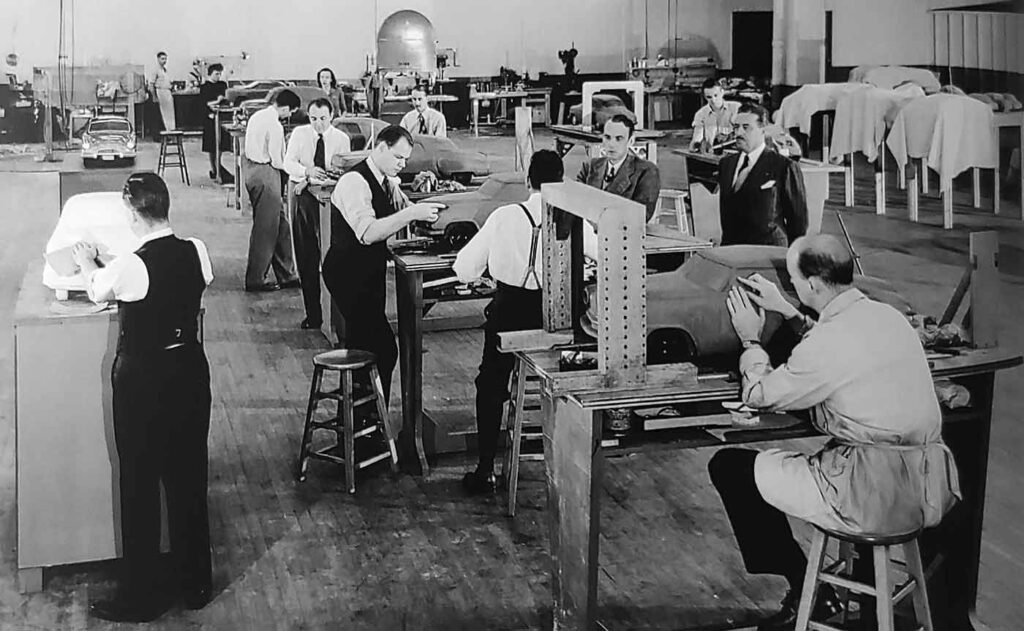
The words of Gordon Buehrig, another mythical name in American automotive design, who also worked for the Loewy Studio at the time are revealing: “Exner was an excellent designer and he was convinced that a job well done spoke for itself, on its own merits. Loewy on the other hand, in addition to being a designer was also a promoter, he was as good at designing as he was at selling his studio’s product, and so he was absolutely convinced that he could legitimately assume for himself the merits of anyone who worked with him”.
After leaving the Loewy Studio, Virgil Exner got a job straight away with Studebaker as head of the design department, but the closure of the prestigious old American factory which could boast of having built the wagons of the pioneers who won the West forced him to take a job with Chrysler soon afterwards, where together with his young assistants Cliff Voss and Maury Baldwin he champed at the bit.
So this agreement with Ghia was the ideal solution: he had admired the work of the Turin coachbuilder on the prototype Plymouth, the future XX 500, and Ghia was the perfect firm to build his designs, the idea cars which would take him back to the limelight of advanced design.
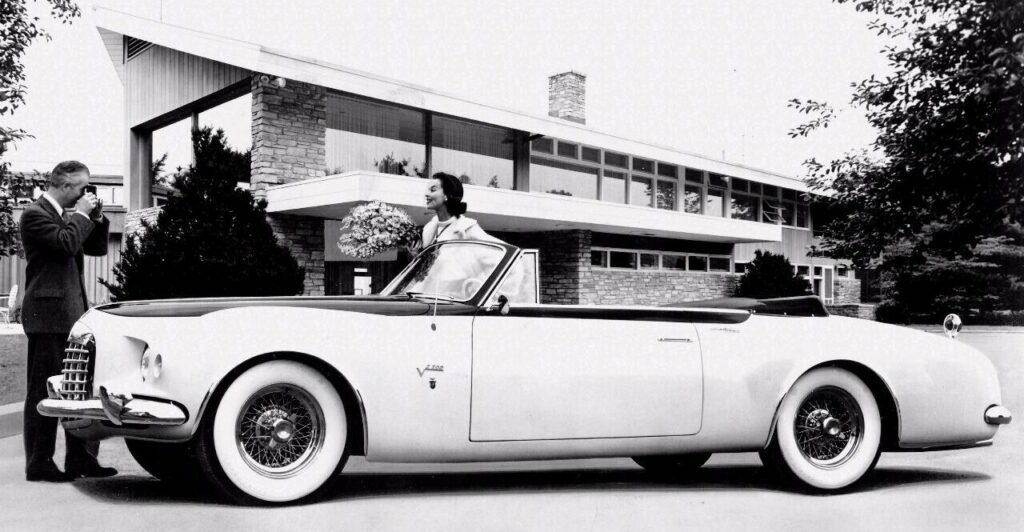
On the other hand, Chrysler’s chairman, K.T. Keller had also been favourably impressed by the Ghia prototype Plymouth, although for different reasons. He had realised immediately in fact that it would be impossible to build such a well-finished prototype, for such a low price – when compared to American standards – as Ghia had. He agreed therefore to the building of two of the Exner group’s prototypes (the K in K310 stood for Keller) and this was the start of a very important period for both houses.
Virgil Exner Junior
For a number of more than comprehensible reasons, young Exner was a protege of Luigi Segre, who of course was pleased to see him come to Ghia. Inevitably there was some friction with Tjaarda, only superficial at first but increasingly serious.
The dissent between Segre and Tjaarda became so profound that the American architect could only leave: it was 1961. Tom Tjaarda only stayed three years at Ghia, but they were three very formative years for him, and he still recognises their importance today. It was a painful parting, but not definitive. Tom Tjaarda went back eight years later to Ghia after this first short period, when he was a well-established designer, to take the place of no less a person than the great Giorgetto Giugiaro, who in turn was leaving his post as artistic director at Carrozzeria Ghia to set up on his own.
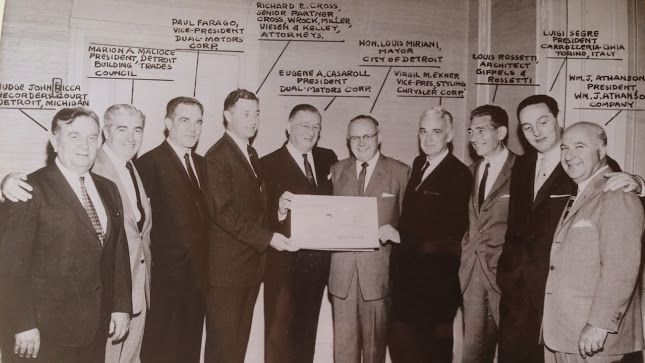
Tom Tjaarda’s departure left the field free for the young Exner. It was generally believed, and is confirmed by Filippo Sapino, who joined Ghia in 1961 and so witnessed the episode, that it was only a question of days before Exner Jr. was offered the post of head of the design office. But against all the odds, he never held the post.
There are several reasons for this, but the main one was the sudden death of Luigi Segre which modified the conditions favourable to Exner Jr. joining Ghia. Furthermore, after a short time his father left Chrysler to set up as a freelance, and obviously this opened up a brand new and certainly more interesting future than one at Ghia.
However, even though he was never formally employed there, the younger Exner definitely left his mark at Ghia. After graduating he had been sent to Germany to do his military service. His thesis was a sports car, with a Simca engine but bearing the Talbot marque, which incorporated many of the ideas already expressed in the Chrysler-Ghia idea cars designed by his father, including the outside exhaust pipe, like the Chrysler Falcon A480. He was able, every now and again, to visit Turin from his base, and to follow the work on the body.
In that period at Ghia there were two parallel structures, virtually independent from each other, but working as they did in a rather small space, there were frequent contacts and exchanges of ideas.
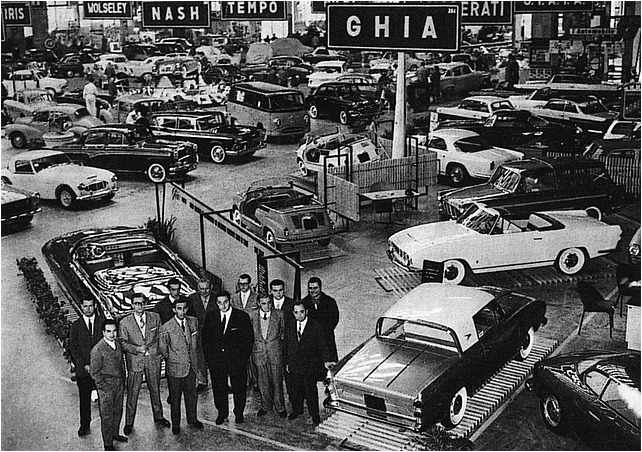
There was the team headed by Sergio Coggiola, which worked on the prototypes and especially on developing the Chrysler jobs. The cars arrived already stylized from America, accompanied by a model in 1:4 scale, and the preliminary designs. Coggiola transformed the material he received into a life-size model and then built the car. Tjaarda recalls, “There was little to do in the way of style, because it all arrived from America, but it was a very important practical school, because it was necessary to find the necessary solutions to carry out the drawings …”. Then there was Sergio Sartorelli’s team which looked after prototypes for the European manufacturers, principal amongst which were Renault and Volvo, customer relations and the production of the “proposals” for Motor Shows, although in those years the only show that counted was the one in Turin. Virgil Exner Jr. did not belong to either of these groups. However, during his whirlwind visits to Turin he was able to make a contribution to some projects too.
His most important contribution, the most widely- diffused one, was his work on for the Fiat 2300 S Coupe, a design done by Sergio Sartorelli.
The final evolution of the Fiat 1800/2100 saloon which finally took Fiat back into the high-class sector of the market as the Fiat 2300. It was from this model that Aurelio Lampredi was given the job of creating a sports version, a real Gran Turismo.
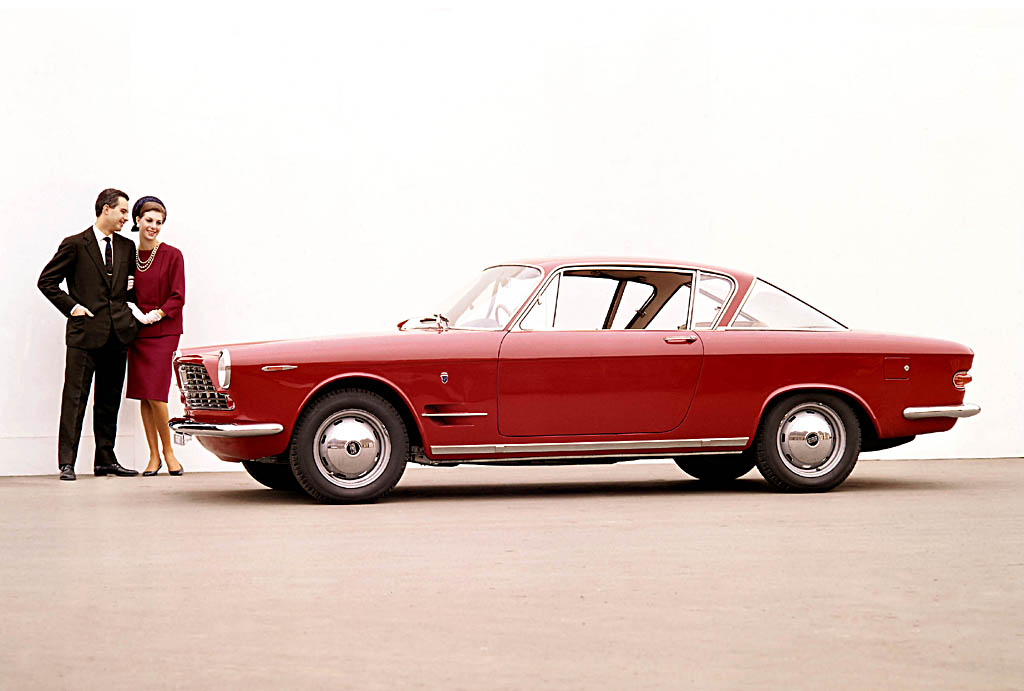
The ex Grand Prix designer from Ferrari had joined Fiat in 1955 when the Maranello firm had managed to overcome one of its periodical technical and economic crises only thanks to the unhoped-for gift of the Lancia competition material, something which took place under Fiat’s aegis. Although it was Lampredi himself who designed the singleseater with which Ferrari won the first two world championships (1952-1953), and achieved other unforgettable successes, when the Lancia material arrived the designer had virtually been shown the door at Ferrari, overnight.
It was therefore. quite natural that Lampredi should nurture ambitions for revenge, to demonstrate his unaltered design skills before everyone. His role as an engine designer at Fiat gave him continued professional satisfaction, but did not assuage his taste for the vendetta he was still pursuing: the 2300S project might have been made for him.
From a technical point of view, the new Fiat was in the classical Lampredi mould, . and the more general Ferrari philosophy: an excellent 6-cylinder engine, big-hearted and pliant, fitted to a rather too traditional frame. But as we know, at Ferrari they were rather used to thinking in terms of engine output, and even though in a few years the English constructors would have demonstrated the opposite case, Lampredi was still firmly convinced he had made the right choice .
The car’s lines had been designed by the office head, Sergio Sartorelli, with the worthy contribution of Virgil Jr. Naturally enough, there were various references to other Ghia models, Segre himself imposed this, especially the roof of the new car. Virgil Jr. was responsible for the rear window of the Fiat 2300 S, which closely resembled the one in the contemporary Chrysler LG.4, and Sergio Sartorelli was definitely the author of the characteristic radiator grill.
Tom Tjaarda worked on some of this project’s details, although strangely he today attributes exclusive paternity to Virgil Jr., completely ignoring the role of Sergio Sartorelli. This is obviously an echo of the disagreement of so long ago which has not yet disappeared: “The Fiat 2300 coupe was designed by Virgil Exner, although I worked on the finalising of many details but the line is definitely his”.
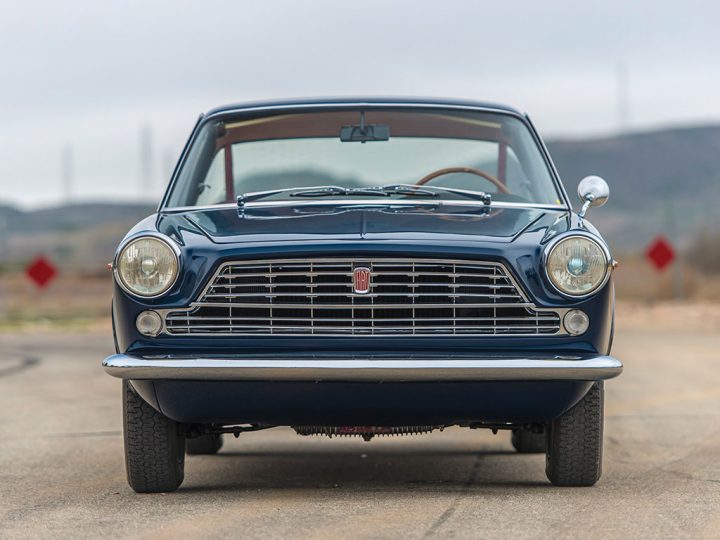
Unfortunately the Fiat coupe did not sell as successfully as one might rightly have assumed such a special model would: it boasted excellent performance figures and very elegant lines, and above all it bore the signature of good designers, whether they were Sartorelli, Tjaarda or Exner. It definitely suffered, as was to be the case a few years later with the splendid Fiat 130 coupe, from belonging to a family which was not particularly noted for high- class cars. During that period Fiat specialised mainly in popular, economic cars.
What seems surprising today is that in a climate of insane passion for everything to do with Ferrari, when even a modest Fiat Dino is pursued to the beat of millions, this splendid 6-cylinder masterpiece by Aurelio Lampredi is completely ignored by enthusiasts …

Ghia also did a wagon, a cabriolet, of which only a small number were sold, and proposed a four-door version to Fiat, a model which could worthily have replaced the production model.
The suggestion came too late, mass production of the model was not feasible, but Fiat did not totally ignore the Ghia proposal. The front of the 2300S, for example, was used in one of the Centro Stile Fiat designs for the new production saloon car, the 1300/ 1500.
Although Segre’s excessive protection of Exner could have made their personal relationship difficult, there was always great mutual esteem and cordiality between Virgil Jr. and Tom Tjaarda.
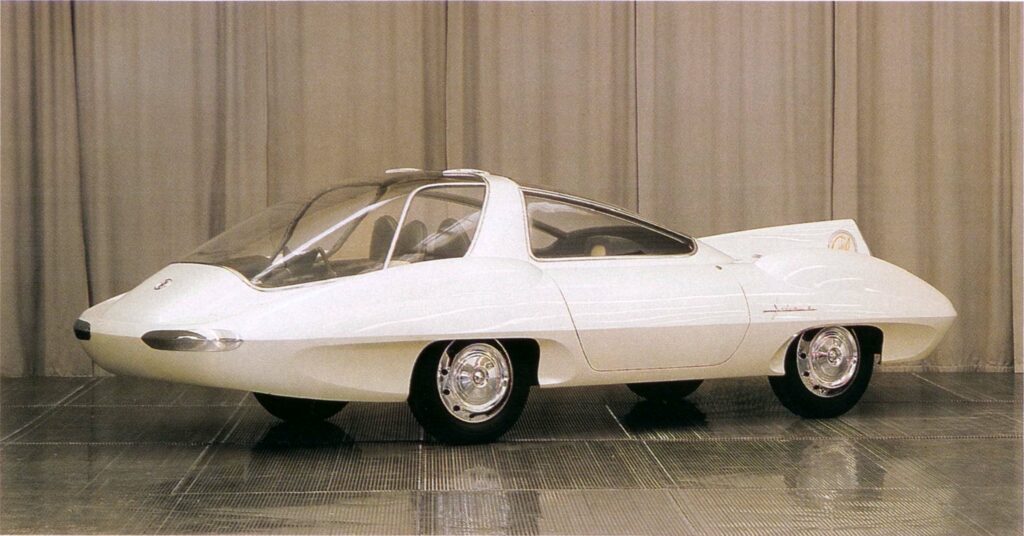
It was only after Tom Tjaarda left Ghia that Virgil Jr. gave into the temptation to design a dream car of his own, and he produced “his” Selene II, almost as if to measure himself against Tom Tjaarda’s Selene I. His preliminary sketches were of definite interest and were developed by Sergio Sartorelli.
It would be unkind to judge a dreamcar according to its practicality, but perhaps Exner went a little too far towards a total lack of rationality with the Selene II: suffice it to say that to reach the driving seat from the single door at the back of the car, it was necessary literally to climb over the passengers!
Show-cars for Chrysler
The first show-car Ghia built for Chrysler has gone down in history for a reason which has absolutely nothing to do with the one for which it was built: the Norseman was to have been exhibited as the world’s most automated car, as far as this was possible with the technology of the time. It was designed by Billie Brownlie, the Exner group’s stylist in charge of the project, and the practical problems involved in building it gave severe headaches to Sergio Coggiola, the capable head of Ghia’s prototype shop. For example, the car had an overhung roof, i.e. it did not sit on the windscreen a-pillars but directly on the glass; discharging onto it any oscillations, with the obvious risk of breakage. Curiously, it was exactly the same problem which Sergio Reggiani, sculptor-designer, and Giannino Marzotto, racing driver in a pin-stripe, had to tackle in their “egg” Ferrari in the 1951 Mille Miglia.
There were also problems connected to housing the sophisticated opening and closing mechanisms for the electrically controlled sunshine roof in the car’s thin roof panel.
Read more: “The Chrysler Norseman“
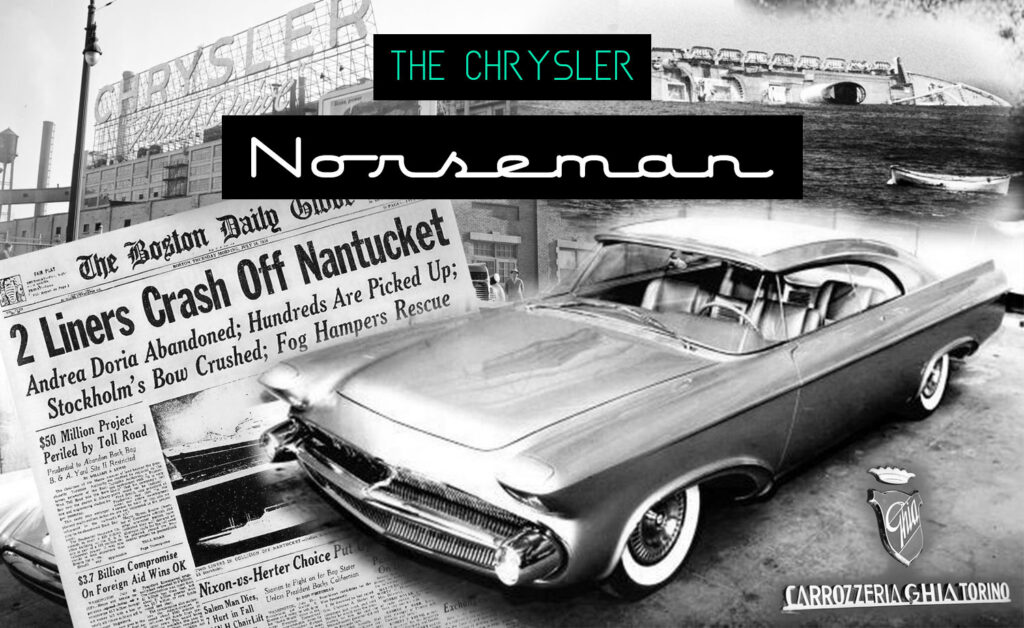
After fifteen months’ work and at a cost of around fifty million lire, the car was finally delivered to the forwarding agent. A month later it was the agent himself who broke the news that the car was lost forever. Since the evening of July 26th. 1956, it had been lying under seventy metres of water in the bay of New York, in the hold of the Andrea Doria. Ghia’s other dream cars were less unfortunate: the Flite-Wing and the Turboflite, the latter adopting many of the solutions used on the Norseman.
Limousines: the official cars
On the morning of November 9th. 1954, in the Belvedere Court of the Vatican Palace in Rome, a short ceremony took place: the Pope, His Holiness Pius XII, was presented with a new car. That day the Carrozzeria Ghia received what was perhaps the most coveted acknowledgment of the quality of its limousines. The Pope’s Chrysler Imperial was not of course the first such important contract to be carried out by the firm belonging to Boano and Segre, but it was certainly the most prestigious one. Ghia had already built a car for Marshal Tito, ruler of Yugoslavia, on the same Chrysler Imperial chassis, and another for the White House. These were all important jobs which had created a certain market for Ghia.
Amongst Ghia’s most faithful customers during those years there was also the Saudi royal family, for whom Ghia produced a parade limousine which included a very powerful radio receiver, something which was not very common at the time on board a car. In 1956, for the same royal customer, Ghia produced two Mercedes-Benz 300’s, one an official open-top state car, and the other a saloon for palace service.
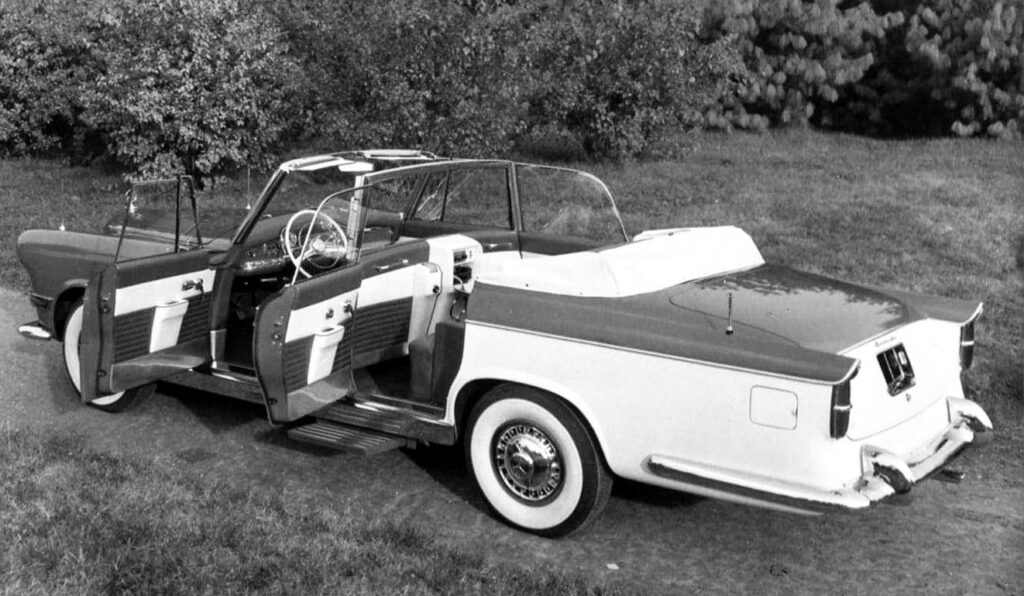
Nor should the car produced on the most noble chassis in the world, the Rolls-Royce Silver Wraith, be forgotten. It was shown at the 1954 Pincio Concours and appeared to be for King Farouk of Egypt, but Gian Paolo Boano is sure that the only Rolls-Royce produced by the company in that period was the one given to Ingrid Bergman by her husband, the film director Roberto Rossellini.
Ghia Crown Imperials
When Luigi Segre managed to negotiate with Chrysler for the contract to transform of a small series of Imperials, the job was entrusted to Sartorelli almost as a matter of course. This was a very interesting contract for Ghia, because Chrysler was to send the Turin coachworks a number of production cars to be stripped down, have their chassis lengthened, and be completely rebuilt to be sold as a special series, the Ghia Crown Imperials.
The first basic designs were American, produced by Virgil Exner, Cliff Voss and Bill Brownlie, the Chrysler Corporation design team, but in time the role passed to Sartorelli directly.
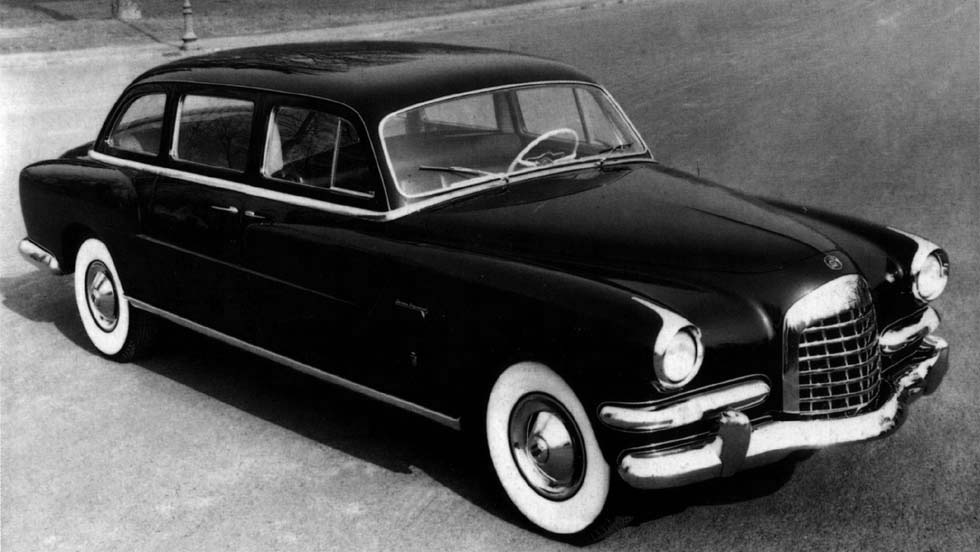
The contract was renewed for nine years, from 1957 to 1965, and the whole time Sartorelli stayed at Ghia, until 1963, he was personally in charge. The Ghia Crown Imperials became parade limousines, used by the White House and Heads of State, both democrats and dictators, with no distinction between the good and the bad: Marshal Tito and General Franco, Queen Elizabeth II of England for her state visit to Canada, and the Arab monarchs. Of these limousines, Sergio Sartorelli remembers the one for the Emir of Kuwait for its originality and for the complexity and richness of the work carried out.
The Chrysler Imperials
There is no doubt that the most important contract Chrysler ever gave to Ghia was the one for a small production series of the prestigious Imperial. The Americans had decided to use Ghia’s production skills on a luxury model to compete with Cadillac, at the time practically unchallenged in the top band of the American market, without having to assume the prohibitive costs of tooling up.
The Chrysler chassis were shipped from the United States by sea, with an unfinished 2-door hard-top body, without doors, windows or seats. The components were shipped separately: windows, doors, air-conditioning plant and even the paint. At Ghia the car was cut and stretched with base and side panels built by Ghia; the ear was then finished by hand, painted, assembled and shipped back to the United States. The contract lasted from 1957 to 1965, and in that time one hundred and thirty-two Chrysler Imperial Limousines were built, of the different models which were updated each year by the American stylists as was customary.
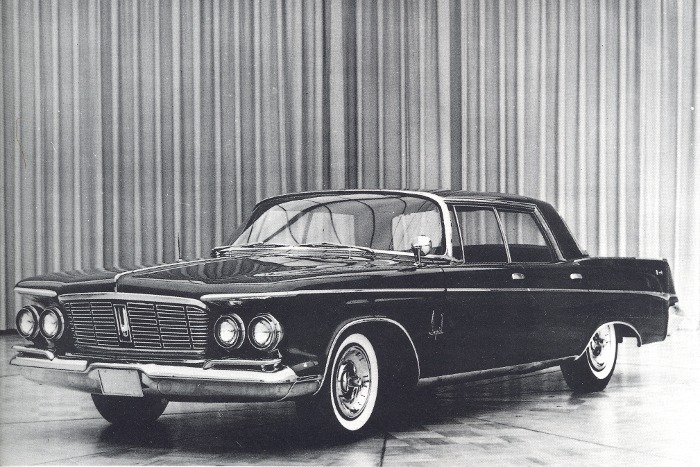
The first contract was for the delivery of twenty- five Imperials between November 1956 and May 1957. The designs were all by Exner, helped by Bill Brownlie and Cliff Voss. The man responsible for coordination between Ghia and Chrysler was Dave Cohoe, and Paul Farago, who moved to Turin for the duration, was contract supervisor. Unlike similar ones which have been stipulated between other firms recently, the contract worked perfectly.
The contract lasted from 1957 to 1965, and in that time 132 Chrysler Imperial Limousines were built, of the different models which were updated each year by the American stylists as was customary.


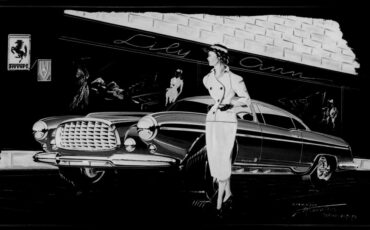
Another very interesting story, thank you! But i just wonder if the Plymouth prototype made by Pinin Farina was done following 100% Chrysler’s blueprint or it was also “customized”… According to the design sketch in the XX-500 Pinin Farina page you linked, its seems like it was designed by Pinin Farina, or at least this is what Pinin Farina wrote…
The XX-500 was a Chrysler design as correctly mentioned by Andreas in the article. Pininfarina only advertised the project.
Great story! Can you write a article about Vignale?
we did! here is the link:
https://www.carrozzieri-italiani.com/the-story-of-carrozzeria-vignale/
Exner, one of my fav designers